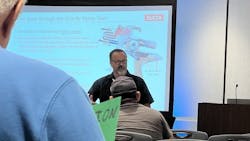How Proper Air Quality and Air Volume Impacts Your Spray Guns
Related To:
July 18, 2024
2 min read
SATA USA hosted a seminar at the ASE Instructor Training Conference in Minneapolis on July 16. During the seminar, instructors covered essential topics related to spray guns but emphasized the importance of proper air volume and pressure.
Tony Larimer, SATA USA’s director of sales and marketing, led the entire event. Larimer highlighted key considerations for achieving optimal performance:
- Air Volume and Pressure: Proper air volume is critical. This begins with selecting the right compressors and ensuring correct plumbing in your shop. Adjustments on spray guns, using regulators that provide sufficient air-CFM (cubic feet per minute), help set pressure correctly and maintain consistency.
- Avoiding Excessive PSI: Larimer cautioned against increasing PSI unnecessarily. Typically, only 29 PSI is needed at the spray gun. Higher PSI can result in high-velocity spray, leading to uneven surfaces and blotches. Many shops run higher air pressure (as much as 90 to 130 PSI) throughout the shop. If the painter has to reduce that pressure at the spray gun with its built-in air micrometer, it chokes off the air supply. High-volume, low-pressure (HVLP) and reduced pressure (RP) guns perform at their best when the wall-mounted regulator in the booth or prep deck is set close to the desired operating pressure and the micrometer is used only to fine-tune the spraying pressure to 29 PSI.
- Imagining Airflow: To illustrate the concept, Larimer asked attendees to visualize breathing through different straws. A fast-food straw provides more volume, allowing for sufficient airflow, while a narrower straw (like those used for stirring drinks) restricts airflow volume.
The seminar also served as an excellent platform for sponsors like SATA to showcase their products, including multi-purpose cups and filters. Dana Davis from Southeast Technical College in Sioux Falls, South Dakota, praised SATA’s user-friendly product line and emphasized the importance of proper maintenance.
About the Author
FenderBender Staff Reporters
The FenderBender staff reporters have nearly four decades of combined journalism and collision repair experience.
Sign up for our eNewsletters
Get the latest news and updates
